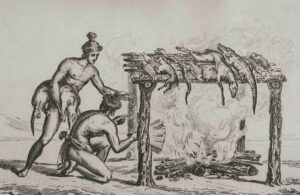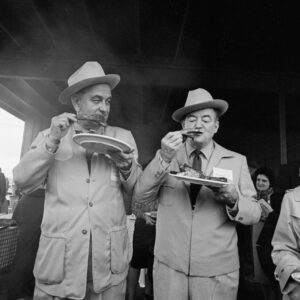Native Americans, European settlers and African slaves all contributed to creating an American culinary tradition.
August 18, 2023
There are more than 30,000 BBQ joints in the U.S., but as far as the Michelin Guide is concerned, not one of them is worthy of a coveted star. Many Americans would say that the fault, dear Brutus, is not in ourselves but in the stars.

A 1562 illustration shows Timucua Indians roasting animals on a raised wooden platform, the original form of barbecuing.
The American barbecue—cooking meat with an indirect flame at low temperature over seasoned wood or charcoal—is a centuries-old tradition. (Using the term for any kind of outdoor grilling came much later.) Like America itself, it is a cultural hybrid. Indigenous peoples in the Caribbean and the Americas would place a whole animal carcass on a wooden platform several feet above a fire and let the smoke do the cooking. The first Spanish arrivals were fascinated by the technique, and translated a native word for the platform as “barbacoa.”

Lyndon B. Johnson (right) and Hubert Humphrey celebrate their election victory with barbecue, November 1964.
The Europeans began to barbecue pigs and cattle, non-native animals that easily adapted to the New World. Another important culinary contribution—using a ground trench instead of a raised platform—may have been spread by African slaves. The 18th century African abolitionist Olaudah Equiano described seeing the Miskito of Honduras, a mixed community of Indians and Africans, barbecue an alligator: “Their manner of roasting is by digging a hole in the earth, and filling it with wood, which they burn to coal, and then they lay sticks across, on which they set the meat.”
European basting techniques also played a role. The most popular recipes for barbecue sauce reflect historic patterns of immigration to the U.S.: British colonists used a simple concoction of vinegar and spices, French émigrés insisted on butter, and German settlers preferred their native mustard. In the American West, two New World ingredients, tomatoes and molasses, formed the basis of many sauces. The type of meat became another regional difference: pork was more plentiful in the South, beef in the West.
Although labor-intensive, a barbecued whole hog can feed up to 150 people, making it the ideal food for communal gatherings. In 1793, President George Washington celebrated the laying of the cornerstone for the Capitol building with an enormous barbecue featuring a 500-pound ox.
In the South before the Civil War, a barbecue meant a hog cooked by slaves. The choicest cuts from the pig’s back went to the grandees, hence the phrase “living high on the hog.” Emancipation brought about a culinary reckoning; Southern whites wanting a barbecue had to turn to cookbooks, such as “Mrs Hill’s New Cook Book,” published in 1867 for “inexperienced Southern housekeepers…in this peculiar crisis of our domestic as well as national affairs.”
In the 20th century, the slower rate of urbanization outside the North helped to keep the outdoor barbecue alive. As a Texan, President Lyndon B. Johnson used “barbecue diplomacy” to project a folksy image, breaking with the refined European style of the Kennedys to endear himself to ordinary Americans. The ingredients in Lady Bird Johnson’s barbecue sauce embraced as many regional varieties as possible by including butter, ketchup and vinegar.
Commercial BBQ sauces, which first became available in 1909, offer a convenient substitute for making your own. But for most people, to experience real barbecue requires that other quintessentially American pastime, the road trip. Just leave the Michelin Guide at home.






 ‘If sack [wine] and sugar be a fault, God help the wicked,” says the rollicking Sir John Falstaff in Shakespeare’s “Henry IV, Part 1.” That was a more innocent time. Nowadays, books such as Gary Taubes’s “The Case Against Sugar” have linked it to many of the world’s health crises, including diabetes, obesity and high blood pressure.
‘If sack [wine] and sugar be a fault, God help the wicked,” says the rollicking Sir John Falstaff in Shakespeare’s “Henry IV, Part 1.” That was a more innocent time. Nowadays, books such as Gary Taubes’s “The Case Against Sugar” have linked it to many of the world’s health crises, including diabetes, obesity and high blood pressure.